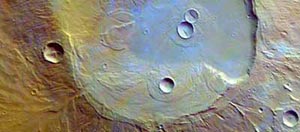Ancient caldera in Apollinaris Patera

Apollinaris Patera is an ancient shield volcano measuring approximately 180 by 280 kilometres at its base and rising to a maximum of 5 kilometres above the surrounding terrain. Shield volcanos are large volcanic structures with gently sloping flanks. The caldera of Apollinaris Patera takes the form of a large crater approximately 80 kilometres in diameter. In this false-colour image, north is to the right. The image also shows the terrain partly covered by thin, diffuse clouds indicated by bluish-tinted areas. This false-colour image was captured on 26 October 2004 by the High-Resolution Stereo Camera (HRSC) onboard the ESA spacecraft Mars Express with a ground resolution of approximately 11.1 metres per pixel. Credits: ESA/DLR/FU Berlin (G. Neukum)
The HRSC obtained these images during orbit 987 with a ground resolution of approximately 11.1 metres per pixel. The images show part of Apollinaris Patera, a volcano lying at approximately 7.2° South and 174.6° East.
Apollinaris Patera is an ancient shield volcano located at the northern edge of the Southern Highlands, lying to the south-east of Elysium Planitia and to the north of Gusev Crater, which is now being explored by NASA's Mars Rover, Spirit.
The volcano measures approximately 180 by 280 kilometres at its base and rises to a maximum of 5 kilometres above the surrounding terrain.
Shield volcanos are large volcanic structures with gently sloping flanks. The caldera of Apollinaris Patera takes the form of a large crater approximately 80 kilometres in diameter and up to 1 kilometre deep. Volcanic calderas are formed when a volcano explodes or when the cone collapses.
In the true-colour image, the terrain is partly covered by thin, diffuse, whitish-appearing clouds. In the false-colour image, the clouds appear as bluish-tinted areas.
The western region of the colour image (top of the image, as north is to the right) is characterized by brighter material, which seems to be layered and could be the result of sedimentary deposition. Distinct layering, causing a terrace-like appearance, is also visible east of this brighter material and in the relatively flat region located in the northwest (top right) of the colour image.
The colour scenes have been derived from the three HRSC-colour channels and the nadir channel. The anaglyph image was calculated from the nadir and one stereo channel. Image resolution has been decreased for use on the internet.
Media Contact
More Information:
http://www.esa.int/SPECIALS/Mars_Express/SEM412AATME_0.htmlAll latest news from the category: Physics and Astronomy
This area deals with the fundamental laws and building blocks of nature and how they interact, the properties and the behavior of matter, and research into space and time and their structures.
innovations-report provides in-depth reports and articles on subjects such as astrophysics, laser technologies, nuclear, quantum, particle and solid-state physics, nanotechnologies, planetary research and findings (Mars, Venus) and developments related to the Hubble Telescope.
Newest articles

Webb captures top of iconic horsehead nebula in unprecedented detail
NASA’s James Webb Space Telescope has captured the sharpest infrared images to date of a zoomed-in portion of one of the most distinctive objects in our skies, the Horsehead Nebula….

Cost-effective, high-capacity, and cyclable lithium-ion battery cathodes
Charge-recharge cycling of lithium-superrich iron oxide, a cost-effective and high-capacity cathode for new-generation lithium-ion batteries, can be greatly improved by doping with readily available mineral elements. The energy capacity and…

Novel genetic plant regeneration approach
…without the application of phytohormones. Researchers develop a novel plant regeneration approach by modulating the expression of genes that control plant cell differentiation. For ages now, plants have been the…





















